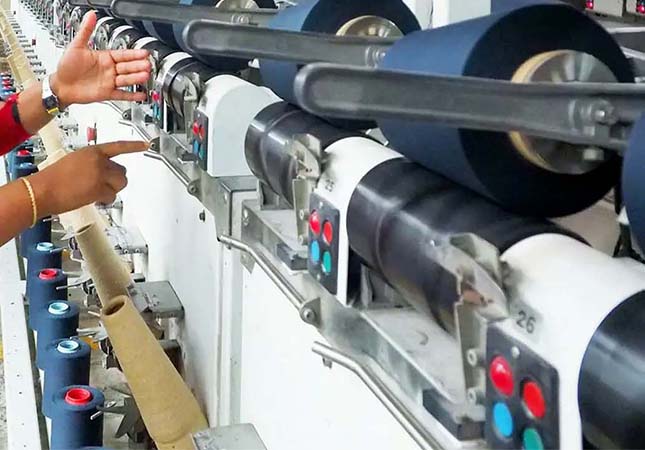Have you ever pondered the techniques behind textile production before the Industrial Revolution? The process demanded considerable manual labor and expertise to craft exquisite textiles. However, the ingenuity of an ancient Chinese invention likely brought some simplification to the craft. Uncover the intriguing tale of the Ancient Textile Weaving Machine in China through this article, and delve into how this remarkable invention sparked a revolution in cloth weaving.

Ancient Textile Weaving Machine in China
In ancient China, a groundbreaking invention transformed the fabric industry – the warp-weighted loom. This remarkable machine, a vertical loom, boasted attached weights at the bottom of its warp threads. The warp threads were carefully stretched horizontally between two beams atop the loom, while the weaver sat on an adjustable platform, allowing them to access different weaving points with ease.
The introduction of the warp-weighted loom brought about a remarkable increase in productivity and efficiency. Weavers could now create much longer lengths of fabric in one go, revolutionizing the textile production process. As a result of its remarkable benefits, this ingenious machine gained widespread popularity and saw extensive use across China. Remarkably, even in modern times, some regions continue to employ this traditional method, especially in places without access to electricity or running water.
History of Weaving
The ancient Chinese were revered for their weaving expertise, and their textile creations were highly sought after by diverse cultures. To keep up with the soaring demand, the Chinese ingeniously devised a machine that could accelerate the weaving process. This marvelous invention was known as the pingtung machine, which specialized in crafting intricate and top-quality textiles.
Operating the pingtung machine required the coordination of two skilled women. The first woman would sit on the lower level, utilizing her feet to power the loom, while the second woman sat on the upper level, deftly guiding the shuttle with her hands. This harmonious collaboration between the two operators rendered the pingtung machine exceptionally efficient, enabling it to produce up to eight bolts of cloth in a single day. Such a remarkable feat ensured that the Chinese met the ever-growing demand for their exceptional textile products.
Types of Weaving Machines
Weaving machines can be categorized into two main types: the hand loom and the power loom. The hand loom is a simple apparatus, activated solely by the weaver's hands, while the power loom is a more intricate mechanism driven by a motor.
The hand loom, being the more straightforward of the two, comprises a frame, a shuttle, and a reed. Positioned in front of the loom, the weaver utilizes her hands to manipulate the shuttle, deftly propelling the thread across the warp threads. Simultaneously, the reed ensures the weft threads settle neatly into place during the weaving process.
On the other hand, the power loom is a technologically advanced device that automates the weaving process. It encompasses a frame, a set of heddles, a harness, a shuttle box, and a take-up roller. A motor empowers the heddles, orchestrating the precise raising and lowering of the warp threads. Within the shuttle box, shuttles deftly throw the weft threads across the warp threads, expertly interlacing the fabric. Meanwhile, the take-up roller diligently winds up the finished fabric as it takes shape during weaving.
For centuries, textile weaving machines have played a vital role in China's textile industry, and their advantages persist in modern times. These machines offer unparalleled control over the fabric, surpassing hand-weaving in producing fabrics with consistent finishes. Moreover, their speed surpasses traditional hand-weaving, significantly boosting fabric production within shorter timeframes.
The benefits of textile weaving machines extend beyond the end product. Operating these machines is notably simpler, reducing the need for extensive training among workers. As a result, there are fewer errors and heightened overall efficiency in the weaving process.
The profound impact of textile weaving machines on the Chinese textile industry remains undeniable, and their relevance endures today. With a multitude of advantages, these machines have solidified their status as an indispensable component of the industry, playing a pivotal role in its continued growth and success.
Recent Advances in Textile Weaving Technology
In present-day China, the textile weaving industry is experiencing a remarkable boom, thanks to groundbreaking technological advancements. This fusion of ancient textile weaving techniques with modern innovations has led to the creation of exquisitely intricate and durable fabrics that captivate the world.
Among the latest advancements, air-jet looms stand out as a game-changer. These cutting-edge looms have revolutionized fabric production by crafting materials that are remarkably lighter and softer than those woven using traditional shuttle looms. Additionally, air-jet looms boast the capacity to weave a vast array of patterns and designs, making them highly favored by designers and fashion houses alike.
Moreover, the incorporation of laser-cut templates in textile weaving technology has proven transformative. These templates facilitate precise cuts and seamless placement of fabric patterns, minimizing waste and eliminating irregularities in the final products.
By harmoniously blending these innovative technologies with time-honored textile weaving techniques, the resulting fabrics embody both exquisite beauty and exceptional strength. As designers continue to explore the vast possibilities offered by this ancient craft, the future of textile weaving appears incredibly promising, promising a tapestry of endless creativity and innovation.
Conclusion
The presence of ancient textile weaving machines has provided a fascinating gateway to unravel the depths of Chinese culture and its evolution. These artifacts not only showcase astonishing craftsmanship but also offer invaluable insights into the technological progress achieved during that era. Journeying from the realm of traditional hand-weaving to the advent of automated mechanized production, the ancient textile weaving machines have gifted us with a profound understanding of China's extensive and vibrant history.




